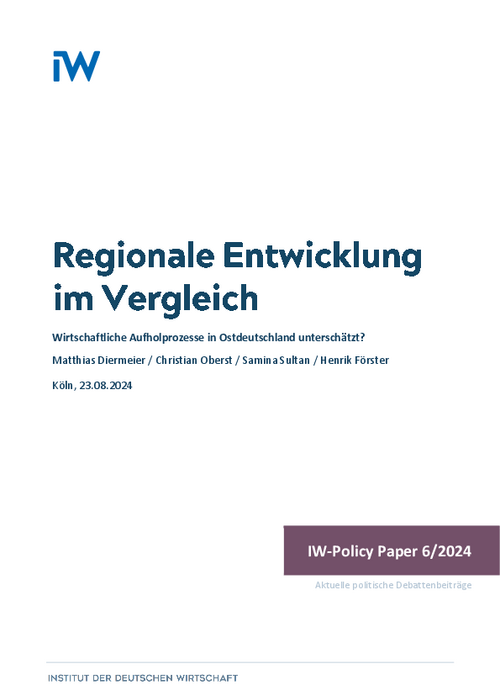Over the past ten years, a clear economic catch-up process can be observed in East Germany in comparison with West Germany.

A comparison of regional development

Over the past ten years, a clear economic catch-up process can be observed in East Germany in comparison with West Germany.
This is shown by the present analysis of unemployment rates and wages at the level of districts and independent cities. Whereas Western German regions show a heterogeneous development, Eastern Germany can be classified as a clear up-and-coming region with only a few exceptions. East and West have moved closer together in terms of both unemployment reduction and wage development.
However, people in Eastern Germany are only to a limited extent aware of these catch-up processes. Despite the significant reduction in unemployment, not even a third of respondents in Eastern Germany in the German Economic Institute’s (IW) People Survey 2024 stated that they were satisfied with developments on the domestic labor market over the past ten years; a third were even explicitly dissatisfied. This negative perception is also found when respondents are asked to classify their region of residence into different types of regions: Just one in five East Germans categorize their place of residence as an up-and-coming region in line with objective developments. Almost half of respondents in upwardly mobile regions in Eastern Germany believe that their region of residence is stagnating; 21 percent even perceive themselves as living in a region that has been left behind.
Reasons for East German pessimism can be found in the demographic challenges. Despite positive economic developments, most districts, with the exception of the districts bordering Berlin in Brandenburg, are experiencing strong shrinking processes. This trend will become even more pronounced in the coming years. With the exceptions of a few cities such as Leipzig, Dresden or Schwerin as well as the surrounding areas of Berlin, the East is suffering massively from population decline. In fact, economic pessimism is particularly pronounced in shrinking regions: 80% of respondents there underestimate the economic development of their region of residence; in the West, the figure is 51% - in each case over 20 percentage points more than in the growing regions.
In particular the political fringes manage to mobilize nationwide in areas with a difficult demographic situation. In shrinking regions of Eastern Germany, the Alternative for Germany (AfD) and the Sahra Wagenknecht Alliance (BSW) are achieving absolute majorities, in some cases with ease. There, the demographic difficulties will become even more acute in the future. This development makes it even more difficult to counter the vicious circle of current emigration, pessimism and a disastrous demographic outlook. After all, a successful economy in the East will be more dependent on qualified immigration in the future than anywhere else. With the majority turning to the political extremes that are critical of or even hostile to migration, the only viable way out of the demographic crisis appears to be blocked.
Economic, political and civil society players in Eastern Germany must address both the perception problem (pessimism) and the challenges of demographic change (ageing, shrinkage and vacancies). Problems should be clearly communicated, and successes just as clearly emphasized. Due to the widespread loss of trust in political actors, companies have an important role to play here. Politicians should focus on enabling equal living conditions. Adequate public services are a basic prerequisite for the future development of a region and provide an opportunity to counteract the described downward spiral.

A comparison of regional development

More on the topic

IW Population Forecast 2024
The demographic transition poses major challenges for policymakers, business and society as a whole. Policymakers seeking solutions to these challenges mainly base their decisions on the quantitative data of population forecasts.
IW
Chapter 3: Regional economic theories as drivers of the EU Cohesion Policy
This chapter reviews the regional economic theories, schools of thought and policy narratives used to motivate the EU Cohesion Policy.
IW